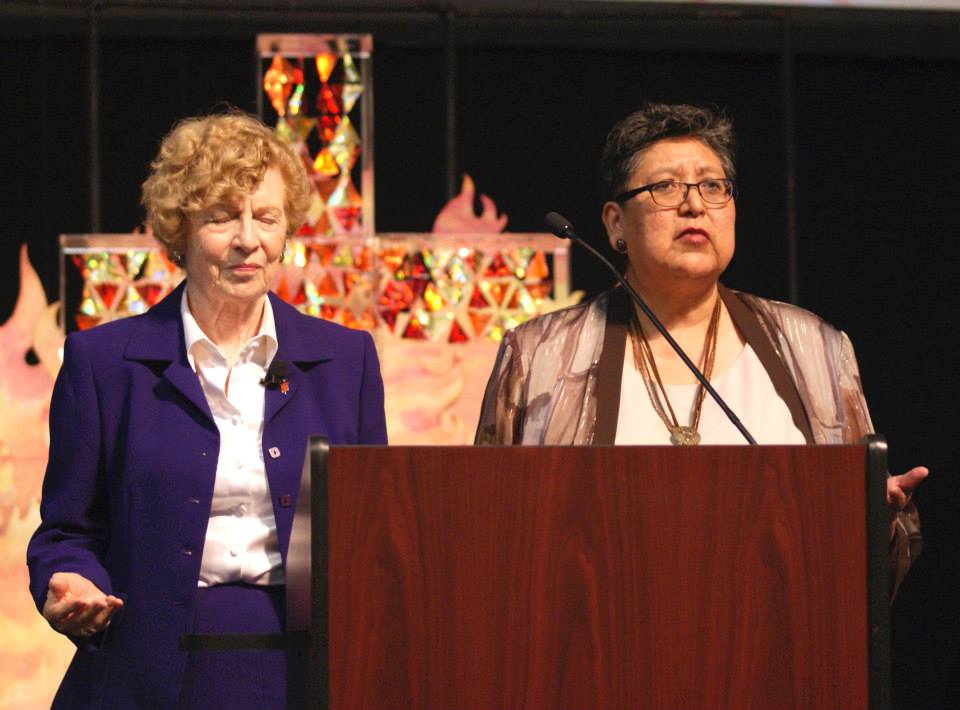
On Sunday, May 14, 2015 after returning from the Annual Conference held at Hofstra University, Pastor Kelvin Jones showed the congregation the gray ribbon tied around his right wrist and explained its significance. He was assisted by his wife, JoAnne, who also attended the conference and by Bob Stewart, an expert in local colonial era “Indian Deeds” as they are called.
In 2012, the United Methodist General Conference — the denomination’s top legislative body — held an Act of Repentance Toward Healing Relationships with Indigenous People service. A General Conference resolution also charged the denomination’s Council of Bishops with carrying out an ongoing process to improve relations with indigenous individuals including local or regional acts of repentance.
At the 2115 session of the New York Annual Conference of the United Methodist Church in their Friday morning session, Bishop Jane Allen Middleton led an Act of Repentance Service.
The purpose of the service was to “repent the United Methodist Church’s role in cooperating with, and entering into those relationships with political forces that resulted in the killing of indigenous men, women and children.”
The most egregious among such acts directly tied to our United Methodist church was the Sand Creek Massacre. A Methodist clergyman-turned-soldier, Col. John Chivington, on Nov. 29, 1864 ordered the cavalry charge that slaughtered a peaceful village of Cheyenne and Arapaho Indians. Some 650 United Methodists visited the site during a Rocky Mountain Conference annual meeting. At the site, visitors learned that Chivington ordered the attack on a village where the peaceful Chief Black Kettle flew both the U.S. flag and a truce flag. The Colorado Territory governor of the time, John Evans, also a Methodist, defended Chivington’s conduct despite a U.S. congressional panel’s finding that he had “surprised, and murdered, in cold blood … unsuspecting men, women, and children.”
Certainly the conflicts of those early American centuries were not completely one-sided. Nor were all the acts of all settlers blameworthy. For example, we learned that when the Cherokees and others were forced West on the trail of tears, there were Methodists who left and went with them in solidarity with their suffering. But, despite the complexity of the whole story, it is crucial as we seek to facilitate reconciliation with indigenous peoples today that we acknowledge the wrongs that were committed by our forefathers in the past. This is in the spirit of the Prophet Daniel’s repentance for the sins of his forefathers (Daniel 9:4-14).
At the close of the NYAC Act of Repentance service, each attender was asked to tie a gray ribbon on their neighbor’s wrist as a reminder. As we tied it we were to repeat the words, “Never Again,” indicating that we would never again allow such unjust behavior toward indigenous peoples to go unchallenged. When we removed the band, we were to ask someone for help, tell someone else its meaning, and say together once more, “Never Again,”
The key dealings for land rights in our area happened two centuries earlier than the Sand Creek tragedy. Bob Stewart has done a great deal of research on the early agreements between settlers and tribes in our area. In our service at Copper Hill he summarized some of the early history. He noted particularly that the Indigenous peoples and the English had completely different concepts regarding the land. Native peoples did not own land. It was only on loan to them. But the English insisted on getting deeds. Bob explained that sometimes the circumstances under which the deeds were obtained were grossly unfair to the Indigenous peoples.
After Bob Stewart’s presentation, Pastor Kelvin asked his wife, JoAnne, to cut the gray ribbon from his wrist and invited the entire congregation to participate in the Act of Repentance by repeating with him the words, “Never Again.”